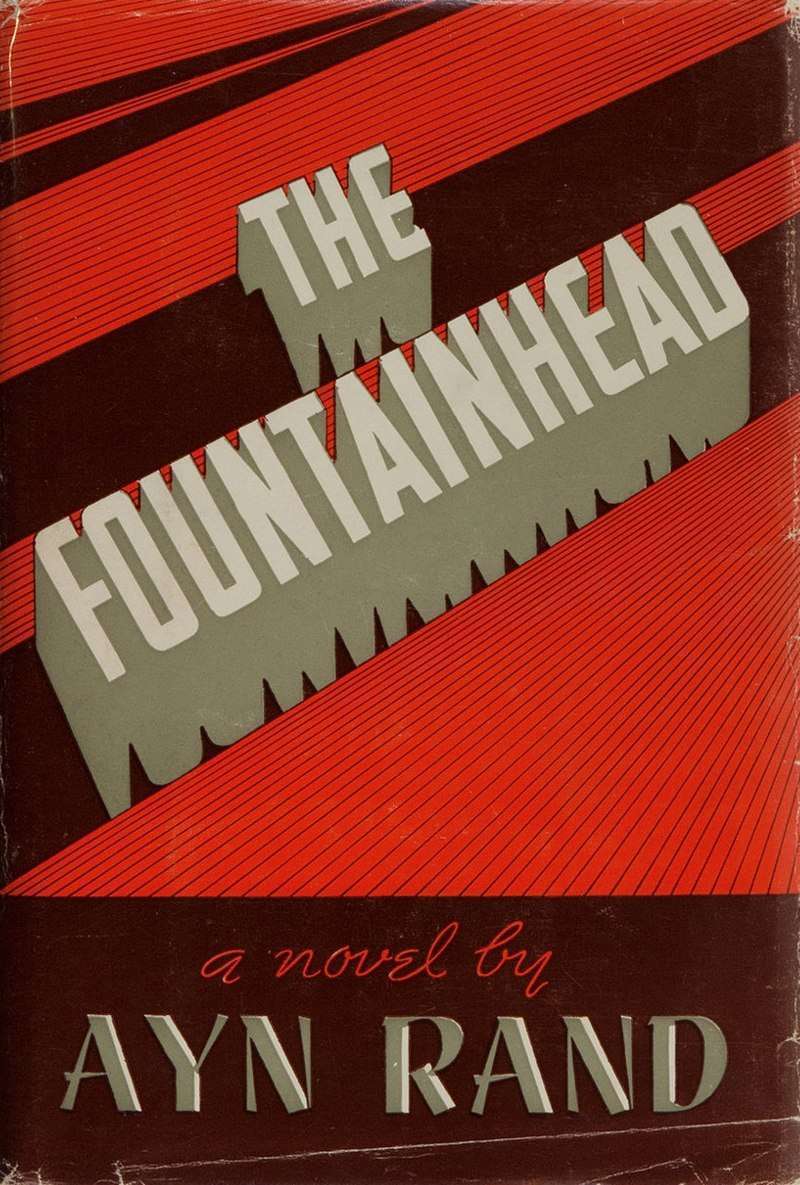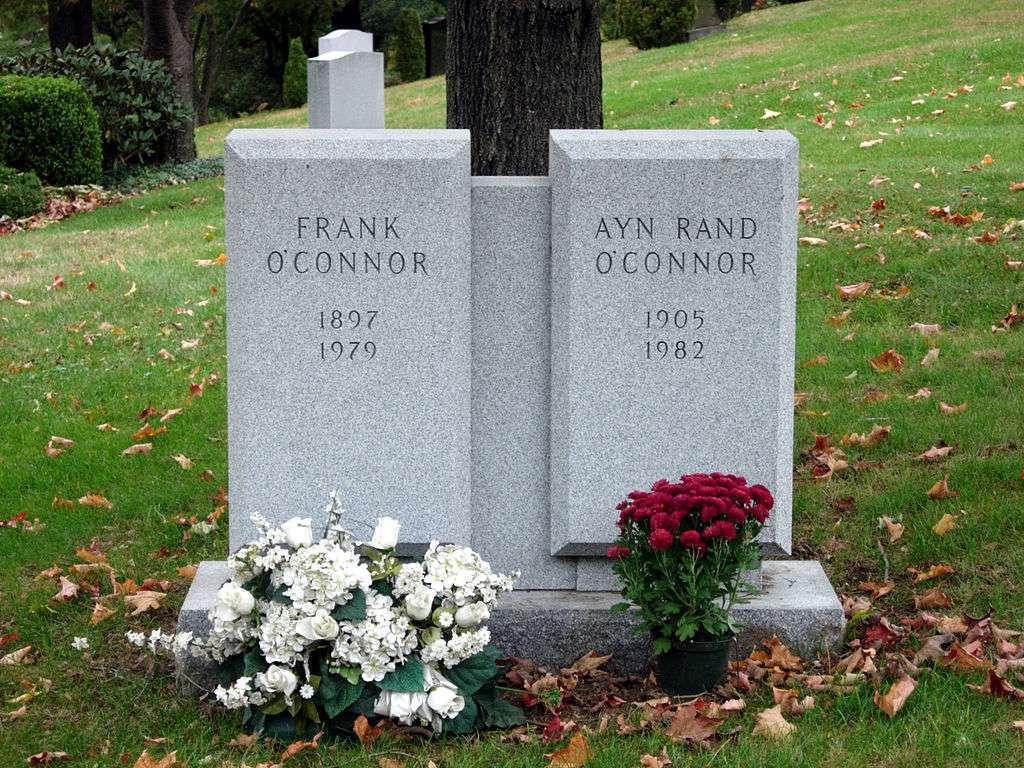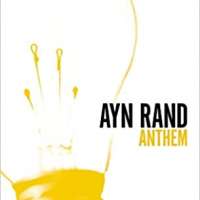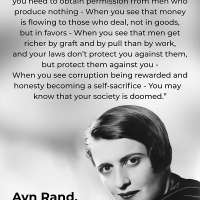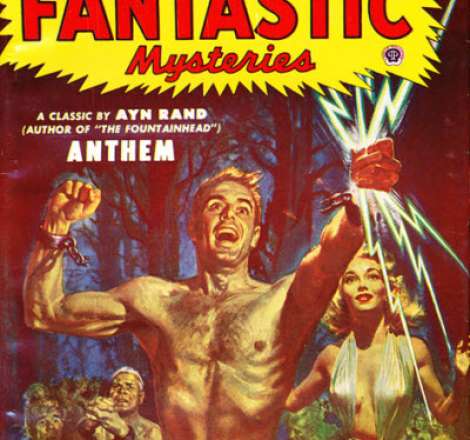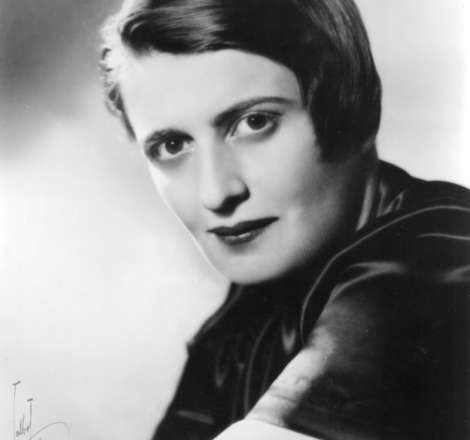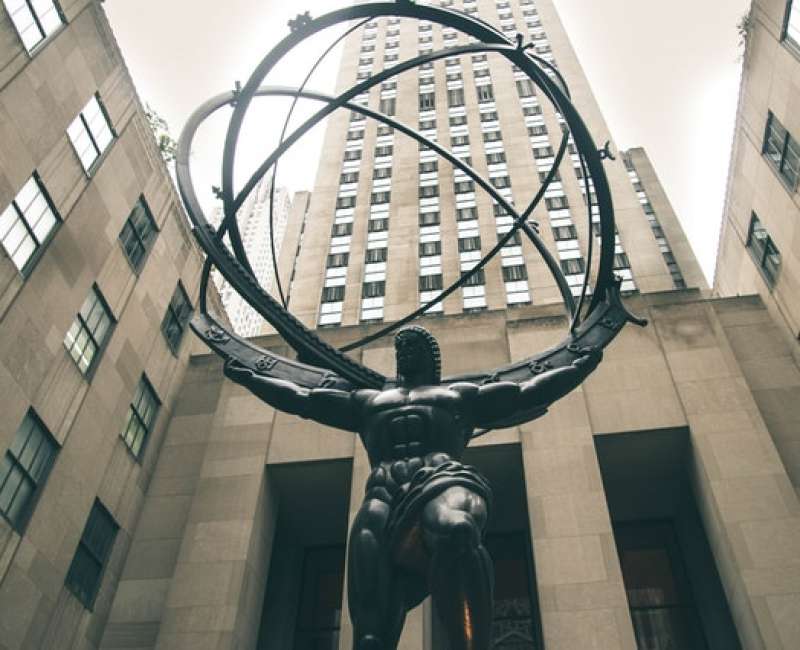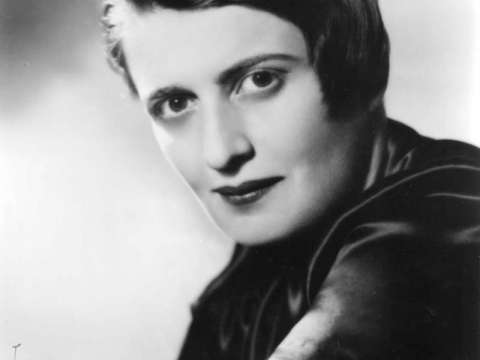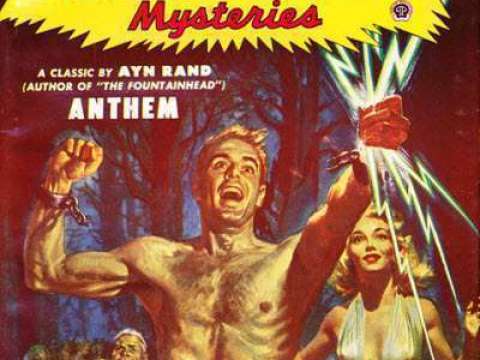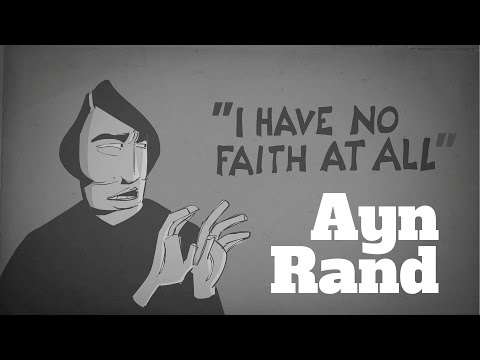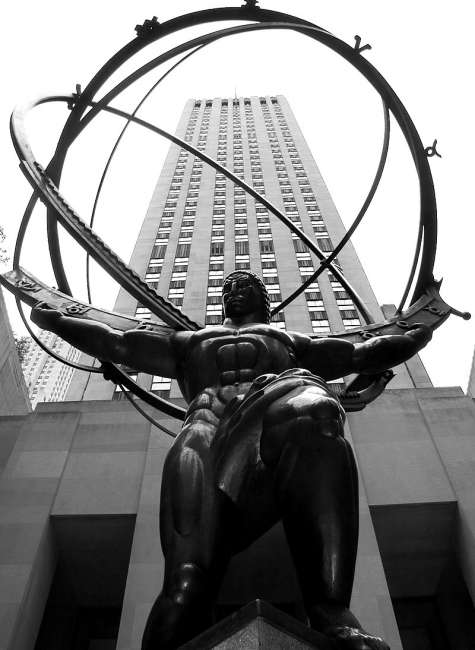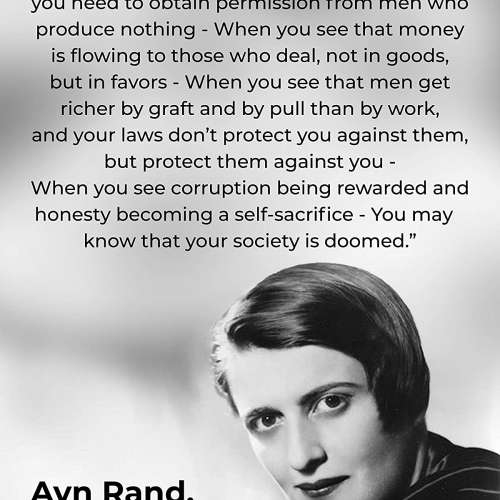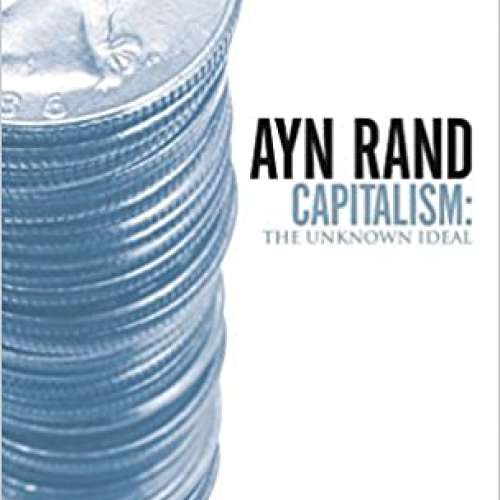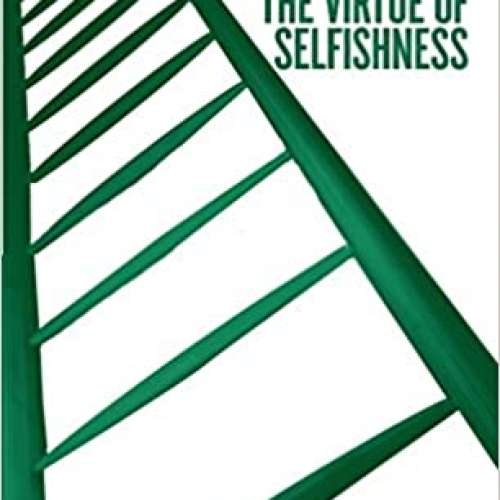

Ayn Rand (1905-1982)

If you don't know, the thing to do is not to get scared, but to learn.
Ayn Rand was a Russian-American writer and philosopher. She is known for her two best-selling novels, The Fountainhead and Atlas Shrugged, and for developing a philosophical system she named Objectivism. Born and educated in Russia, she moved to the United States in 1926. She had a play produced on Broadway in 1935 and 1936. After two early novels that were initially unsuccessful, she achieved fame with her 1943 novel, The Fountainhead. In 1957, Rand published her best-known work, the novel Atlas Shrugged. Afterward, she turned to non-fiction to promote her philosophy, publishing her own periodicals and releasing several collections of essays until her death in 1982.
Rand advocated reason as the only means of acquiring knowledge and rejected faith and religion. She supported rational and ethical egoism and rejected altruism. In politics, she condemned the initiation of force as immoral and opposed collectivism and statism as well as anarchism, instead supporting laissez-faire capitalism, which she defined as the system based on recognizing individual rights, including property rights. In art, Rand promoted romantic realism. She was sharply critical of most philosophers and philosophical traditions known to her, except for Aristotle, Thomas Aquinas and classical liberals.
Literary critics received Rand's fiction with mixed reviews and academia generally ignored or rejected her philosophy, though academic interest has increased in recent decades. The Objectivist movement attempts to spread her ideas, both to the public and in academic settings. She has been a significant influence among libertarians and American conservatives.
Life
Early life
Rand was born Alisa Zinovyevna Rosenbaum Russian: Алиса Зиновьевна Розенбаум on February 2, 1905, to a Russian-Jewish bourgeois family living in Saint Petersburg. She was the eldest of three daughters of Zinovy Zakharovich Rosenbaum and Anna Borisovna née Kaplan. Her father was an upwardly mobile pharmacist and her mother was socially ambitious and religiously observant. Rand later said she found school unchallenging and began writing screenplays at the age of eight and novels at the age of ten. At the prestigious Stoiunina Gymnasium , her closest friend was Vladimir Nabokov's younger sister, Olga. The two girls shared an intense interest in politics and would engage in debates at the Nabokov mansion: while Olga defended constitutional monarchy, Alisa supported republican ideals.
She was twelve at the time of the February Revolution of 1917, during which she favored Alexander Kerensky over Tsar Nicholas II. The subsequent October Revolution and the rule of the Bolsheviks under Vladimir Lenin disrupted the life the family had previously enjoyed. Her father's business was confiscated, and the family fled to the Crimean Peninsula, which was initially under control of the White Army during the Russian Civil War. While in high school, she concluded that she was an atheist and valued reason above any other human virtue. After graduating from high school in the Crimea in June 1921, she returned with her family to Petrograd as Saint Petersburg was renamed at that time, where they faced desperate conditions, on occasion nearly starving.
After the Russian Revolution, universities were opened to women, allowing her to be in the first group of women to enroll at Petrograd State University. At the age of 16, she began her studies in the department of social pedagogy, majoring in history. At the university she was introduced to the writings of Aristotle and Plato, who would be her greatest influence and counter-influence, respectively. She also studied the philosophical works of Friedrich Nietzsche. Able to read French, German and Russian, she also discovered the writers Fyodor Dostoevsky, Victor Hugo, Edmond Rostand, and Friedrich Schiller, who became her perennial favorites.

Along with many other bourgeois students, she was purged from the university shortly before graduating. After complaints from a group of visiting foreign scientists, however, many of the purged students were allowed to complete their work and graduate, which she did in October 1924. She then studied for a year at the State Technicum for Screen Arts in Leningrad. For an assignment, she wrote an essay about the Polish actress Pola Negri, which became her first published work.
By this time, she had decided her professional surname for writing would be Rand, possibly because it is graphically similar to a vowelless excerpt Рзнб of her birth surname in Cyrillic handwriting, and she adopted the first name Ayn, either from a Finnic name Aino or from the Hebrew word עין ayin, meaning "eye".
Arrival in the United States
In late 1925, Rand was granted a visa to visit relatives in Chicago. She departed on January 17, 1926. When she arrived in New York City on February 19, 1926, she was so impressed with the skyline of Manhattan that she cried what she later called "tears of splendor". Intent on staying in the United States to become a screenwriter, she lived for a few months with her relatives, one of whom owned a movie theater and allowed her to watch dozens of films free of charge. She then left for Hollywood, California.
In Hollywood, a chance meeting with famed director Cecil B. DeMille led to work as an extra in his film The King of Kings and a subsequent job as a junior screenwriter. While working on The King of Kings, she met an aspiring young actor, Frank O'Connor; the two were married on April 15, 1929. She became a permanent American resident in July 1929 and an American citizen on March 3, 1931. Taking various jobs during the 1930s to support her writing, she worked for a time as the head of the costume department at RKO Studios. She made several attempts to bring her parents and sisters to the United States, but they were unable to acquire permission to emigrate.
Early fiction
Rand's first literary success came with the sale of her screenplay Red Pawn to Universal Studios in 1932, although it was never produced. This was followed by the courtroom drama Night of January 16th, first produced by E. E. Clive in Hollywood in 1934 and then successfully reopened on Broadway in 1935. Each night a jury was selected from members of the audience; based on the jury's vote, one of two different endings would be performed. In 1941, Paramount Pictures produced a movie loosely based on the play. Rand did not participate in the production and was highly critical of the result. Ideal is a novel and play written in 1934 which were first published in 2015 by her estate. The heroine is an actress who embodies Randian ideals.

Rand's first published novel, the semi-autobiographical We the Living, was published in 1936. Set in Soviet Russia, it focused on the struggle between the individual and the state. In a 1959 foreword to the novel, Rand stated that We the Living "is as near to an autobiography as I will ever write. It is not an autobiography in the literal, but only in the intellectual sense. The plot is invented, the background is not ..." Initial sales were slow and the American publisher let it go out of print, although European editions continued to sell. After the success of her later novels, Rand was able to release a revised version in 1959 that has since sold over three million copies. In 1942, without Rand's knowledge or permission, the novel was made into a pair of Italian films, Noi vivi and Addio, Kira. Rediscovered in the 1960s, these films were re-edited into a new version which was approved by Rand and re-released as We the Living in 1986.
Her novella Anthem was written during a break from the writing of her next major novel, The Fountainhead. It presents a vision of a dystopian future world in which totalitarian collectivism has triumphed to such an extent that even the word 'I' has been forgotten and replaced with 'we'. It was published in England in 1938, but Rand initially could not find an American publisher. As with We the Living, Rand's later success allowed her to get a revised version published in 1946, which has sold more than 3.5 million copies.
The Fountainhead and political activism
During the 1940s, Rand became politically active. She and her husband worked as full-time volunteers for the 1940 presidential campaign of Republican Wendell Willkie. This work led to Rand's first public speaking experiences; she enjoyed fielding sometimes hostile questions from New York City audiences who had viewed pro-Willkie newsreels. This activity brought her into contact with other intellectuals sympathetic to free-market capitalism. She became friends with journalist Henry Hazlitt and his wife, and Hazlitt introduced her to the Austrian School economist Ludwig von Mises. Despite her philosophical differences with them, Rand strongly endorsed the writings of both men throughout her career, and both of them expressed admiration for her. Mises once referred to Rand as "the most courageous man in America", a compliment that particularly pleased her because he said "man" instead of "woman". Rand also became friends with libertarian writer Isabel Paterson. Rand questioned Paterson about American history and politics long into the night during their many meetings and gave Paterson ideas for her only non-fiction book, The God of the Machine.

Rand's first major success as a writer came in 1943 with The Fountainhead, a romantic and philosophical novel that she wrote over a period of seven years. The novel centers on an uncompromising young architect named Howard Roark and his struggle against what Rand described as "second-handers"—those who attempt to live through others, placing others above themselves. It was rejected by twelve publishers before finally being accepted by the Bobbs-Merrill Company on the insistence of editor Archibald Ogden, who threatened to quit if his employer did not publish it. While completing the novel, Rand was prescribed the amphetamine Benzedrine to fight fatigue. The drug helped her to work long hours to meet her deadline for delivering the novel, but afterwards she was so exhausted that her doctor ordered two weeks' rest. Her use of the drug for approximately three decades may have contributed to what some of her later associates described as volatile mood swings.
The Fountainhead became a worldwide success, bringing Rand fame and financial security. In 1943, Rand sold the rights for a film version to Warner Bros. and she returned to Hollywood to write the screenplay. Finishing her work on that screenplay, she was hired by producer Hal B. Wallis as a screenwriter and script-doctor. Her work for Wallis included the screenplays for the Oscar-nominated Love Letters and You Came Along. Rand also worked on other projects, including a planned nonfiction treatment of her philosophy to be called The Moral Basis of Individualism. Although the planned book was never completed, a condensed version was published as an essay titled "The Only Path to Tomorrow" in the January 1944 edition of Reader's Digest magazine.
Rand extended her involvement with free-market and anti-communist activism while working in Hollywood. She became involved with the Motion Picture Alliance for the Preservation of American Ideals, a Hollywood anti-Communist group, and wrote articles on the group's behalf. She also joined the anti-Communist American Writers Association. A visit by Isabel Paterson to meet with Rand's California associates led to a final falling out between the two when Paterson made comments, which Rand considered rude, to valued political allies. In 1947, during the Second Red Scare, Rand testified as a "friendly witness" before the United States House Un-American Activities Committee. Her testimony described the disparity between her personal experiences in the Soviet Union and the portrayal of it in the 1944 film Song of Russia. Rand argued that the film grossly misrepresented conditions in the Soviet Union, portraying life there as much better and happier than it actually was. She wanted to also criticize the lauded 1946 film The Best Years of Our Lives for what she interpreted as its negative presentation of the business world, but she was not allowed to testify about it. When asked after the hearings about her feelings on the effectiveness of the investigations, Rand described the process as "futile".
After several delays, the film version of The Fountainhead was released in 1949. Although it used Rand's screenplay with minimal alterations, she "disliked the movie from beginning to end", and complained about its editing, acting, and other elements.
Atlas Shrugged and Objectivism
In the years following the publication of The Fountainhead, Rand received numerous letters from readers, some of whom the book profoundly influenced. In 1951, Rand moved from Los Angeles to New York City, where she gathered a group of these admirers around her. This group jokingly designated "The Collective" included future Chair of the Federal Reserve Alan Greenspan, a young psychology student named Nathan Blumenthal later Nathaniel Branden and his wife Barbara, and Barbara's cousin Leonard Peikoff. Initially the group was an informal gathering of friends who met with Rand on weekends at her apartment to discuss philosophy. She later began allowing them to read the drafts of her new novel, Atlas Shrugged, as the manuscript pages were written. In 1954, Rand's close relationship with the younger Nathaniel Branden turned into a romantic affair, with the "grudging consent" of their spouses.

Atlas Shrugged, published in 1957, was considered Rand's magnum opus. Rand described the theme of the novel as "the role of the mind in man's existence—and, as a corollary, the demonstration of a new moral philosophy: the morality of rational self-interest". It advocates the core tenets of Rand's philosophy of Objectivism and expresses her concept of human achievement. The plot involves a dystopian United States in which the most creative industrialists, scientists, and artists respond to a welfare state government by going on strike and retreating to a mountainous hideaway where they build an independent free economy. The novel's hero and leader of the strike, John Galt, describes the strike as "stopping the motor of the world" by withdrawing the minds of the individuals most contributing to the nation's wealth and achievement. With this fictional strike, Rand intended to illustrate that without the efforts of the rational and productive, the economy would collapse and society would fall apart. The novel includes elements of mystery, romance, and science fiction, and it contains an extended exposition of Objectivism in the form of a lengthy monologue delivered by Galt.
Despite many negative reviews, Atlas Shrugged became an international bestseller. In an interview with Mike Wallace, Rand declared herself "the most creative thinker alive". However, Rand was discouraged and depressed by the reaction of intellectuals to the novel. Atlas Shrugged was Rand's last completed work of fiction; it marked the end of her career as a novelist and the beginning of her role as a popular philosopher. In 1958, Nathaniel Branden established Nathaniel Branden Lectures, later incorporated as the Nathaniel Branden Institute NBI, to promote Rand's philosophy. Collective members gave lectures for NBI and wrote articles for Objectivist periodicals that she edited. Rand later published some of these articles in book form.
Critics, including some former NBI students and Branden himself, later described the culture of NBI as one of intellectual conformity and excessive reverence for Rand, with some describing NBI or the Objectivist movement itself as a cult or religion. Rand expressed opinions on a wide range of topics, from literature and music to sexuality and facial hair, and some of her followers mimicked her preferences, wearing clothes to match characters from her novels and buying furniture like hers. However, some former NBI students believed the extent of these behaviors was exaggerated, and the problem was concentrated among Rand's closest followers in New York. Rand was unimpressed with many of the NBI students and held them to strict standards, sometimes reacting coldly or angrily to those who disagreed with her.
Later years
Throughout the 1960s and 1970s, Rand developed and promoted her Objectivist philosophy through her nonfiction works and by giving talks to students at institutions such as Yale, Princeton, Columbia, Harvard, and the Massachusetts Institute of Technology. She received an honorary Doctorate of Humane Letters from Lewis & Clark College on 2 October 1963. She also began delivering annual lectures at the Ford Hall Forum, responding afterward to questions from the audience. During these speeches and Q&A sessions, she often took controversial stances on political and social issues of the day. These included supporting abortion rights, opposing the Vietnam War and the military draft but condemning many draft dodgers as "bums", supporting Israel in the Yom Kippur War of 1973 against a coalition of Arab nations as "civilized men fighting savages", saying European colonists had the right to develop land taken from American Indians, and calling homosexuality "immoral" and "disgusting", while also advocating the repeal of all laws about it. She also endorsed several Republican candidates for President of the United States, most strongly Barry Goldwater in 1964, whose candidacy she promoted in several articles for The Objectivist Newsletter.
In 1964, Nathaniel Branden began an affair with the young actress Patrecia Scott, whom he later married. Nathaniel and Barbara Branden kept the affair hidden from Rand. When she learned of it in 1968, though her romantic relationship with Branden had already ended, Rand terminated her relationship with both Brandens, which led to the closure of NBI. Rand published an article in The Objectivist repudiating Nathaniel Branden for dishonesty and other "irrational behavior in his private life". In subsequent years, Rand and several more of her closest associates parted company.
Rand underwent surgery for lung cancer in 1974 after decades of heavy smoking. In 1976, she retired from writing her newsletter and, after her initial objections, she allowed social worker Evva Pryor, an employee of her attorney, to enroll her in Social Security and Medicare. During the late 1970s her activities within the Objectivist movement declined, especially after the death of her husband on November 9, 1979. One of her final projects was work on a never-completed television adaptation of Atlas Shrugged.
Rand died of heart failure on March 6, 1982, at her home in New York City, and was interred in the Kensico Cemetery, Valhalla, New York. Rand's funeral was attended by some of her prominent followers, including Alan Greenspan. A 6-foot 1.8 m floral arrangement in the shape of a dollar sign was placed near her casket. In her will, Rand named Leonard Peikoff to inherit her estate.
Philosophy
Rand called her philosophy "Objectivism", describing its essence as "the concept of man as a heroic being, with his own happiness as the moral purpose of his life, with productive achievement as his noblest activity, and reason as his only absolute". She considered Objectivism a systematic philosophy and laid out positions on metaphysics, epistemology, ethics, political philosophy, and aesthetics.
In metaphysics, Rand supported philosophical realism, and opposed anything she regarded as mysticism or supernaturalism, including all forms of religion.
In epistemology, she considered all knowledge to be based on sense perception, the validity of which she considered axiomatic, and reason, which she described as "the faculty that identifies and integrates the material provided by man's senses". She rejected all claims of non-perceptual or a priori knowledge, including "'instinct,' 'intuition,' 'revelation,' or any form of 'just knowing'". In her Introduction to Objectivist Epistemology, Rand presented a theory of concept formation and rejected the analytic–synthetic dichotomy.
In ethics, Rand argued for rational and ethical egoism rational self-interest, as the guiding moral principle. She said the individual should "exist for his own sake, neither sacrificing himself to others nor sacrificing others to himself". She referred to egoism as "the virtue of selfishness" in her book of that title, in which she presented her solution to the is-ought problem by describing a meta-ethical theory that based morality in the needs of "man's survival qua man". She condemned ethical altruism as incompatible with the requirements of human life and happiness, and held that the initiation of force was evil and irrational, writing in Atlas Shrugged that "Force and mind are opposites."
Rand's political philosophy emphasized individual rights including property rights, and she considered laissez-faire capitalism the only moral social system because in her view it was the only system based on the protection of those rights. She opposed statism, which she understood to include theocracy, absolute monarchy, Nazism, fascism, communism, democratic socialism, and dictatorship. Rand believed that natural rights should be protected by a constitutionally limited government. Although her political views are often classified as conservative or libertarian, she preferred the term "radical for capitalism". She worked with conservatives on political projects, but disagreed with them over issues such as religion and ethics. She denounced libertarianism, which she associated with anarchism. She rejected anarchism as a naïve theory based in subjectivism that could only lead to collectivism in practice.
In aesthetics, Rand defined art as a "selective re-creation of reality according to an artist's metaphysical value-judgments". According to her, art allows philosophical concepts to be presented in a concrete form that can be easily grasped, thereby fulfilling a need of human consciousness. As a writer, the art form Rand focused on most closely was literature, where she considered romanticism to be the approach that most accurately reflected the existence of human free will. She described her own approach to literature as "romantic realism".
Rand acknowledged Aristotle as her greatest influence and remarked that in the history of philosophy she could only recommend "three A's"—Aristotle, Aquinas, and Ayn Rand. In a 1959 interview with Mike Wallace, when asked where her philosophy came from she responded: "Out of my own mind, with the sole acknowledgement of a debt to Aristotle, the only philosopher who ever influenced me. I devised the rest of my philosophy myself." However, she also found early inspiration in Friedrich Nietzsche, and scholars have found indications of his influence in early notes from Rand's journals, in passages from the first edition of We the Living which Rand later revised, and in her overall writing style. However, by the time she wrote The Fountainhead, Rand had turned against Nietzsche's ideas, and the extent of his influence on her even during her early years is disputed.
Rand considered her philosophical opposite to be Immanuel Kant, whom she referred to as "the most evil man in mankind's history", primarily for his philosophy regarding the limitations of reason.
Rand said her most important contributions to philosophy were her "theory of concepts, ethics, and discovery in politics that evil—the violation of rights—consists of the initiation of force". She believed epistemology was a foundational branch of philosophy and considered the advocacy of reason to be the single most significant aspect of her philosophy, stating: "I am not primarily an advocate of capitalism, but of egoism; and I am not primarily an advocate of egoism, but of reason. If one recognizes the supremacy of reason and applies it consistently, all the rest follows."
Reception and legacy
Critical reception
During Rand's lifetime, her work evoked both extreme praise and condemnation. Rand's first novel, We the Living, was admired by the literary critic H. L. Mencken, her Broadway play Night of January 16th was both a critical and popular success, and The Fountainhead was hailed by The New York Times reviewer Lorine Pruette as "masterful". Rand's novels were derided by some critics when they were first published as being long and melodramatic. However, they became bestsellers largely through word of mouth.
The first reviews Rand received were for Night of January 16th. Reviews of the production were largely positive, but Rand considered even positive reviews to be embarrassing because of significant changes made to her script by the producer. Rand believed that her first novel, We the Living, was not widely reviewed, but Rand scholar Michael S. Berliner writes "it was the most reviewed of any of her works", with approximately 125 different reviews being published in more than 200 publications. Overall these reviews were more positive than the reviews she received for her later work. Her 1938 novella Anthem received little attention from reviewers, both for its first publication in England and for subsequent re-issues.
Rand's first bestseller, The Fountainhead, received far fewer reviews than We the Living, and reviewers' opinions were mixed. Lorine Pruette's positive review in The New York Times was one that Rand greatly appreciated. Pruette called Rand "a writer of great power" who wrote "brilliantly, beautifully and bitterly", and stated that "you will not be able to read this masterful book without thinking through some of the basic concepts of our time". There were other positive reviews, but Rand dismissed most of them as either not understanding her message or as being from unimportant publications. Some negative reviews focused on the length of the novel, such as one that called it "a whale of a book" and another that said "anyone who is taken in by it deserves a stern lecture on paper-rationing". Other negative reviews called the characters unsympathetic and Rand's style "offensively pedestrian".
Rand's 1957 novel Atlas Shrugged was widely reviewed and many of the reviews were strongly negative. In National Review, conservative author Whittaker Chambers called the book "sophomoric" and "remarkably silly". He described the tone of the book as "shrillness without reprieve" and accused Rand of supporting a godless system which he related to that of the Soviets, claiming "From almost any page of Atlas Shrugged, a voice can be heard, from painful necessity, commanding: 'To a gas chamber—go!'". Atlas Shrugged received positive reviews from a few publications, including praise from the noted book reviewer John Chamberlain, but Rand scholar Mimi Reisel Gladstein later wrote that "reviewers seemed to vie with each other in a contest to devise the cleverest put-downs", calling it "execrable claptrap" and "a nightmare"—they also said it was "written out of hate" and showed "remorseless hectoring and prolixity".
Rand's nonfiction received far fewer reviews than her novels had. The tenor of the criticism for her first nonfiction book, For the New Intellectual, was similar to that for Atlas Shrugged, with philosopher Sidney Hook likening her certainty to "the way philosophy is written in the Soviet Union", and author Gore Vidal calling her viewpoint "nearly perfect in its immorality". Her subsequent books got progressively less attention from reviewers.
In 2005, on the 100th anniversary of Rand's birth, Edward Rothstein, writing for The New York Times, referred to her fictional writing as quaint utopian "retro fantasy" and programmatic neo-Romanticism of the misunderstood artist while criticizing her characters' "isolated rejection of democratic society". In 2007, book critic Leslie Clark described her fiction as "romance novels with a patina of pseudo-philosophy". In 2009, GQ's critic columnist Tom Carson described her books as "capitalism's version of middlebrow religious novels" such as Ben-Hur and the Left Behind series. Reviewing the posthumously published novel Ideal, The New York Times chief book critic Michiko Kakutani assessed Rand's "didactic, ideological work" as stylistically having a great deal "in common with the message-minded socialist realism produced in the Soviet Union, which she left in the mid-1920s and vociferously denounced".
Popular interest
In 1991, a survey conducted for the Library of Congress and the Book-of-the-Month Club asked club members what the most influential book in the respondent's life was. Rand's Atlas Shrugged was the second most popular choice, after the Bible. Rand's books continue to be widely sold and read, with over 29 million copies sold as of 2013 with about 10% of that total purchased for free distribution to schools by the Ayn Rand Institute. In 1998, Modern Library readers voted Atlas Shrugged the 20th century's finest work of fiction, followed by The Fountainhead in second place, Anthem in seventh, and We the Living eighth; none of the four appeared on the critics' list. Although Rand's influence has been greatest in the United States, there has been international interest in her work.
Rand's contemporary admirers included fellow novelists, such as Ira Levin, Kay Nolte Smith and L. Neil Smith; and later writers such as Erika Holzer and Terry Goodkind have been influenced by her. Other artists who have cited Rand as an important influence on their lives and thought include comic book artist Steve Ditko and musician Neil Peart of Rush, although he later distanced himself. Rand provided a positive view of business and subsequently many business executives and entrepreneurs have admired and promoted her work. John Allison of BB&T and Ed Snider of Comcast Spectacor have funded the promotion of Rand's ideas, while Mark Cuban owner of the Dallas Mavericks as well as John P. Mackey CEO of Whole Foods among others have said they consider Rand crucial to their success.
Rand and her works have been referred to in a variety of media: on television shows including animated sitcoms, live-action comedies, dramas, and game shows, as well as in movies and video games. She, or a character based on her, figures prominently in positive and negative lights in literary and science fiction novels by prominent American authors. One such depiction is found in the character Anna Granite with her philosophy of Definitivism in Mary Gaitskill's 1991 novel Two Girls, Fat and Thin. Nick Gillespie, editor in chief of Reason, has remarked that "Rand's is a tortured immortality, one in which she's as likely to be a punch line as a protagonist..." and that "jibes at Rand as cold and inhuman, run through the popular culture". Two movies have been made about Rand's life. A 1997 documentary film, Ayn Rand: A Sense of Life, was nominated for the Academy Award for Best Documentary Feature. The Passion of Ayn Rand, a 1999 television adaptation of the book of the same name, won several awards. Rand's image also appears on a 1999 U.S. postage stamp illustrated by artist Nick Gaetano. A satirical film by artist and scholar Zach Blas called Jubilee 2033, exhibited primarily in art galleries and museums, features a young Ayn Rand and Alan Greenspan traveling through time to visit a dystopian Silicon Valley, whose success and ruin is attributed to Rand's technologist followers such as Peter Thiel.
Political influence
Although she rejected the labels "conservative" and "libertarian", Rand has had continuing influence on right-wing politics and libertarianism. Jim Powell, a senior fellow at the Cato Institute, considers Rand one of the three most important women along with Rose Wilder Lane and Isabel Paterson of modern American libertarianism, and David Nolan, one of the founders of the Libertarian Party, stated that "without Ayn Rand, the libertarian movement would not exist". In his history of the libertarian movement, journalist Brian Doherty described her as "the most influential libertarian of the twentieth century to the public at large" and biographer Jennifer Burns referred to her as "the ultimate gateway drug to life on the right". Economist and Ayn Rand student George Reisman wrote: "Ayn Rand...in particular, must be cited as providing a philosophical foundation for the case of capitalism, and as being responsible probably more than anyone else for the current spread of pro-capitalist ideas."

She faced intense opposition from William F. Buckley Jr. and other contributors for the National Review magazine. They published numerous criticisms in the 1950s and 1960s by Whittaker Chambers, Garry Wills, and M. Stanton Evans. Nevertheless, her influence among conservatives forced Buckley and other National Review contributors to reconsider how traditional notions of virtue and Christianity could be integrated with support for capitalism.
The political figures who cite Rand as an influence are usually conservatives often members of the Republican Party, despite Rand taking some positions that are atypical for conservatives, such as being pro-choice and an atheist. A 1987 article in The New York Times referred to her as the Reagan administration's "novelist laureate". Republican Congressmen and conservative pundits have acknowledged her influence on their lives and have recommended her novels.
The financial crisis of 2007–2008 spurred renewed interest in her works, especially Atlas Shrugged, which some saw as foreshadowing the crisis. Opinion articles compared real-world events with the plot of the novel. During this time, signs mentioning Rand and her fictional hero John Galt appeared at Tea Party protests. There was also increased criticism of her ideas, especially from the political left, with critics blaming the economic crisis on her support of selfishness and free markets, particularly through her influence on Alan Greenspan. For example, Mother Jones remarked that "Rand's particular genius has always been her ability to turn upside down traditional hierarchies and recast the wealthy, the talented, and the powerful as the oppressed" while equating Randian individual well-being with that of the Volk according to Goebbels. Corey Robin of The Nation alleged similarities between the "moral syntax of Randianism" and fascism.
Academic reaction
Scholarly reception during Rand's lifetime
During Rand's lifetime, her work received little attention from academic scholars. When the first academic book about Rand's philosophy appeared in 1971, its author declared writing about Rand "a treacherous undertaking" that could lead to "guilt by association" for taking her seriously. A few articles about Rand's ideas appeared in academic journals before her death in 1982, many of them in The Personalist. One of these was "On the Randian Argument" by libertarian philosopher Robert Nozick, who argued that her meta-ethical argument is unsound and fails to solve the is–ought problem posed by David Hume. Other philosophers, writing in the same publication, argued that Nozick misstated Rand's case. Academic consideration of Rand as a literary figure during her life was even more limited. Academic Mimi Gladstein was unable to find any scholarly articles about Rand's novels when she began researching her in 1973, and only three such articles appeared during the rest of the 1970s.
Posthumous overall assessments
Since Rand's death, interest in her work has gradually increased. In 2009, historian Jennifer Burns identified "three overlapping waves" of scholarly interest in Rand, including "an explosion of scholarship" since the year 2000. However, as of that same year, few universities included Rand or Objectivism as a philosophical specialty or research area, with many literature and philosophy departments dismissing her as a pop culture phenomenon rather than a subject for serious study.

Writing in the 1998 edition of the Routledge Encyclopedia of Philosophy, political theorist Chandran Kukathas summarizes the mainstream philosophical reception to her work in two parts. Her ethical argument, he says, is viewed by most commentators as an unconvincing variant of Aristotle's ethics. Her political theory, he says, "is of little interest", marred by an "ill-thought out and unsystematic" effort to reconcile her hostility to the state with her rejection of anarchism. Libertarian philosopher Michael Huemer argues that very few people find Rand's ideas convincing, especially her ethics, which he believes are difficult to interpret and may lack logical coherence. He attributes the attention she receives to her being a "compelling writer", especially as a novelist, noting that Atlas Shrugged outsells Rand's non-fiction works as well as the works of other philosophers of classical liberalism such as Ludwig von Mises, Friedrich Hayek, or Frederic Bastiat.
Several critics claim that the 1863 novel "What Is to Be Done?" by Russian author Nikolay Chernyshevsky is an embodiment of rational egoism and one of the sources of inspiration for Rand's thought. For example, the book's main character Lopuhov says "I am not a man to make sacrifices. And indeed there are no such things. One acts in the way that one finds most pleasant."
Regarding Rand's particular disdain for the philosophy of Immanuel Kant, philosophers George Walsh and Fred Seddon have argued that she misinterpreted Kant and exaggerated their differences.
Political scientist Charles Murray, while praising Rand's literary accomplishments, criticizes her claim that her only "philosophical debt" was to Aristotle, instead asserting that her ideas were derivative of previous thinkers such as John Locke and Friedrich Nietzsche. Although Rand maintained that Objectivism was an integrated philosophical system, philosopher Robert H. Bass argues that her central ethical ideas are inconsistent and contradictory to her central political ideas.
In the Literary Encyclopedia entry for Rand written in 2001, John David Lewis declared that "Rand wrote the most intellectually challenging fiction of her generation".
Rand-specific scholarship
Some scholars focus specifically on Rand's work. In 1987 Allan Gotthelf, George Walsh and David Kelley co-founded the Ayn Rand Society, a group affiliated with the American Philosophical Association. Gladstein, Harry Binswanger, Allan Gotthelf, John Hospers, Edwin A. Locke, Wallace Matson, Leonard Peikoff, Chris Matthew Sciabarra, and Tara Smith have taught her work in academic institutions. Sciabarra co-edits the Journal of Ayn Rand Studies, a nonpartisan peer-reviewed journal dedicated to the study of Rand's philosophical and literary work. In a 1999 interview in the Chronicle of Higher Education, Sciabarra commented, "I know they laugh at Rand", while forecasting a growth of interest in her work in the academic community.
In 2012, the University of Pittsburgh Press launched an "Ayn Rand Society Philosophical Studies" series based on the proceedings of the Society. Smith has written several academic books and papers on Rand's ideas, including Ayn Rand's Normative Ethics: The Virtuous Egoist, a volume on Rand's ethical theory published by Cambridge University Press. Rand's ideas have also been made subjects of study at Clemson and Duke universities. Scholars of English and American literature have largely ignored her work, although attention to her literary work has increased since the 1990s.
Rand scholars Douglas Den Uyl and Douglas B. Rasmussen, while stressing the importance and originality of her thought, describe her style as "literary, hyperbolic and emotional". Political writer and Rand scholar Jack Wheeler writes that despite "the incessant bombast and continuous venting of Randian rage", Rand's ethics are "a most immense achievement, the study of which is vastly more fruitful than any other in contemporary thought".
Objectivist movement
In 1985, Rand's intellectual heir, Leonard Peikoff, established the Ayn Rand Institute, a nonprofit organization dedicated to promoting Rand's ideas and works. In 1990, after an ideological disagreement with Peikoff, philosopher David Kelley founded the Institute for Objectivist Studies, now known as The Atlas Society. In 2001, historian John McCaskey organized the Anthem Foundation for Objectivist Scholarship, which provides grants for scholarly work on Objectivism in academia. The charitable foundation of BB&T Corporation has also given grants for teaching Rand's ideas or works. The University of Texas at Austin, the University of Pittsburgh, and University of North Carolina at Chapel Hill are among the schools that have received grants. In some cases, these grants have been controversial due to their requiring research or teaching related to Rand.
Selected works
Novels:
- 1936 We the Living
- 1943 The Fountainhead
- 1957 Atlas Shrugged
Other fiction:
- 1934 Night of January 16th
- 1938 Anthem
- 2015 Ideal
Non-fiction:
More facts



